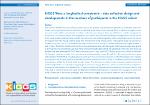KiGGS Wave 2 longitudinal component – data collection design and developments in the numbers of participants in the KiGGS cohort
Lange, Michael
Hoffmann, Robert
Mauz, Elvira
Houben, Robin
Gößwald, Antje
Schaffrath Rosario, Angelika
Kurth, Bärbel-Maria
The German Health Interview and Examination Survey for Children and Adolescents (KiGGS) is conducted within the
health monitoring framework that has been established at the Robert Koch Institute (RKI). In addition to regular crosssectional
studies of the current health of children and adolescents living in Germany, KiGGS also includes a longitudinal
component – the KiGGS cohort. The longitudinal data, which can be linked individually throughout the various waves
of the study, enables developments in health and their associated influencing factors to be analysed during the life course.
Participants from the KiGGS baseline study form the baseline of the KiGGS cohort. The baseline study was carried out
between 2003 and 2006 as a nationwide interview and examination survey of children and adolescents aged between 0
and 17 years. The KiGGS cohort comprises the 17,641 participants who, after taking part in the baseline study, also agreed
to participate in recurring follow-ups that are to continue through adolescence into adulthood. Until now, two follow-up
studies have been conducted: KiGGS Wave 1 (2009-2012, n=11,992) and KiGGS Wave 2 (2014-2017), which, in line with
the baseline study, was conducted as an interview and examination survey. A total of 10,853 repeat participants were
interviewed for KiGGS Wave 2; 6,465 people also took part in an examination. As such, 61.3% of the people who originally
participated in the baseline study also provided data from interviews for KiGGS Wave 2. In addition, 50.8% have provided
various forms of data for all three of the survey’s waves. This data pool can help answer numerous questions from the
epidemiological life course discipline regarding the population living in Germany; at the time of the baseline study, these
participants were children and adolescents. In order to exploit the full potential of the study for life course research and
to be able to trace the health and social development of different generations in the future, the concepts on which the
study is based are to be further developed, and innovative strategies for participant retention are to be drawn up.
Files in this item

